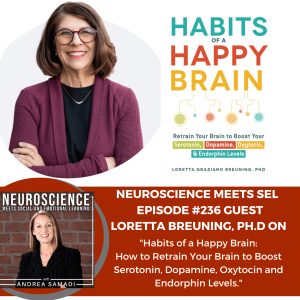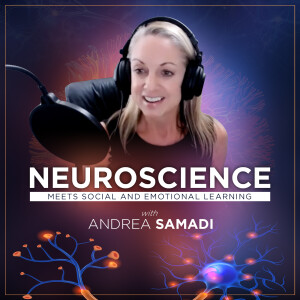
Loretta Breuning, Ph.D. on ”Habits of a Happy Brain: Rewiring Your Brain to Boost Serotonin, Oxytocin, and Endorphin Levels”
 2022-08-04
2022-08-04
The secret of being happy is accepting where you are in life and making the most out of every day….
Or is it? Is there a secret to happiness that we can uncover by looking into the chemicals in our brain? We will find this out today.
Watch this interview on YouTube here https://youtu.be/6Sb8wAsvwQ8
On the episode we will explore:
✔ A deep dive into the four happy chemicals in our brain.
✔ How to move past old patterns, behaviors and stress response circuits in our brain, for new results.
✔ Healthy ways to increase our happiness neurotransmitters.
✔ Vicious cycles we should all be aware of, and ways to break these cycles.
✔ How to rewire a "low trust" brain and what we can learn from how monkeys build trust in others.
Welcome back to The Neuroscience Meets Social and Emotional Learning Podcast, where we cover the science-based evidence behind social and emotional learning (for schools) and emotional intelligence training (in the workplace) with tools, ideas and strategies that we can all use for immediate results.
I’m Andrea Samadi, and on today’s episode #236, we have Loretta Breuning, the Founder of the Inner Mammal Institute,[i] Professor Emerita of Management at California State University and the author of Habits of a Happy Brain[ii] and Status Games: Why We Play and How to Stop. Her work has appeared in The Wall Street Journal, Psychology Today, Real Simple and numerous podcasts.
Loretta helps people to build their power over their mammalian brain chemistry, reminding us that “happiness comes from chemicals we’ve inherited from earlier mammals: dopamine, serotonin, oxytocin and endorphin levels. When you know how they work in animals, your ups and downs make sense. Our happy chemicals evolved to reward survival behaviors, not to make us feel good all the time. But you can feel good more often when you understand nature’s operating system.”
Let’s meet Dr. Loretta Breuning and learn together, how to retrain our brain to boost our serotonin, dopamine, oxytocin and endorphin levels, for a happier and healthier life by understanding why these neurotransmitters are important for happiness to occur in the present moment of our lives.
Welcome Loretta, thank you for coming on the podcast. We have been focused on our brain as it relates to learning, and when I saw your book, Habits of a Happy Brain I jumped to learn more about it, because who doesn’t want to learn more about our brain chemistry, especially when it comes to retraining our brain for happiness.
INTRO Q: Can we start with where your interest in this topic began? How did you go from being a University Professor, to writing books about our brain chemistry and connecting us back to our “inner mammal” and how our brain is wired for survival?
Q1: You mentioned something in another interview[iii], that I think is important for us to understand. You said “we are all wired by our early experiences because this is when we have the most neuroplasticity.” What should we all know about how our brains are wired, that makes us all unique, right down to the level of the neurons in our brain?
Q1B: So, if we are to dive deeper into this, you know how we all have a trauma response, or when we are stressed, or experiencing overwhelm, we experience either fight (anger/irritability) flight (let’s talk about something else and avoid all of this) freeze (unable to move and disassociate), or fawn (where you keep the peace as a people please to avoid conflict)…all of these reactions hard-wired from our early experiences. I’m sure each of us, if asked, could think about which trauma response we use predominately. Once we are aware of our stress response circuit, what do we do with that? Is it enough to just pay attention to whatever it is that’s causing a reaction and notice if it’s really a threat to you, or if we can just move beyond it?
Q2: When I think about happiness, I don’t usually think about what’s going on at the brain level (until reading your book). I’m thinking, I want to move towards this, or I don’t. This makes me feel good, or it doesn’t. Do more of X, and less of Y. What’s behind this feeling of happiness? What 4 chemicals are showing up in the brain, and what should we know about how these 4 brain chemicals work? (Page 14)
Q2B: To intentionally retrain our brain towards more happiness, is this a good formula? “look for the joy=dopamine, beware of masking my pain, it will be temporary (endorphins), look for those I trust (oxytocin) and keep an eye on my pride/desire for social importance with serotonin? Is this enough, or am I missing anything important? (Page 16)
2C: What are healthy ways to increase each neurotransmitter?
Q3: How does our brain wire itself early in life, and how difficult is it to break old wiring/habits?
Q4: What are some common vicious cycles we should be aware of? What is the solution to getting out of these cycles, or resisting habits that make you feel good in the moment, and then bad later?
Q4B: What tools do you have for people who are struggling to break a habit?
Q5: In Chapter 2, Meet Your Happy Chemicals, you say that “your dopamine circuits are built from your past experiences” and “that dopamine builds a neural template that helps you find your rewards” (page 36, Habits of a Happy Brain) all built from our life experiences, like the child who discovers a berry patch with their mother, triggering dopamine with the whole experience. What happens to the rush this person feels later in life, (eating berries, or other experiences that have been wired into the brain) and what should we understand about the ups and downs of dopamine?
Q5B: How can we translate this understanding into our parenting?
Q6: What about endorphin, that “masks pain for a short time” (Page 41) “that is only released if you push past your capacity to the point of distress” and allows you to move forward. We have recently addressed chronic pain[iv], with ways to retrain our brain using mindfulness and meditation, along with other strategies, but endorphin doesn’t seem to be a long-term solution to pain management. How does it contribute to our happiness if it’s a short-term solution to our pain?
Q7: What is the connection between oxytocin and trust? If you were standing in front of someone who just feels off to you for some reason, what happens at your brain level? Is oxytocin ONLY secreted with trust?
Q7B: You say that “our oxytocin pathways are built with life experience” (page 48) so would it make sense that if we have a hard time trusting in our past experiences that these neural pathways would lean towards mistrust with others until we had rewired a new pathway of trust?
Q7C: How would you rewire a “low-trust’ pattern in our brain?
Q8: How can we recognize when serotonin is flowing in our brain as we seek that feeling of being important or being respected, and how do our past serotonin experiences create our present expectations?
Q9: What is your 45-day plan to rewire our brain towards happiness? How can we take all of this and make it applicable?
Q10: Why does our brain create unhappiness? What’s important with experiencing the contrast of happiness and it’s opposite?
Q11: Is there anything important that I have missed?
Final Thoughts:
Thank you Dr. Breuning for sharing your Habits of a Happy Brain and all of your research on this podcast. For people to learn more about your work, and access the incredible free video series you’ve created, I will put the link to your resources and where people can follow you in the show notes.
FOLLOW DR. LORETTA BREUNING
WEBSITE https://innermammalinstitute.org/trainings/
TWITTER https://twitter.com/InnerMammal
FACEBOOK https://www.facebook.com/LorettaBreuningPhD
LINKEDIN https://www.linkedin.com/in/lorettabreuning/
YOUTUBE https://www.youtube.com/c/InnerMammalInstitute
FOLLOW ANDREA SAMADI:
YouTube Channel: https://www.youtube.com/c/AndreaSamadi
Website https://www.achieveit360.com/
LinkedIn: https://www.linkedin.com/in/samadi/
Facebook: https://www.facebook.com/Achieveit360com
Neuroscience Meets SEL Facebook Group https://www.facebook.com/groups/2975814899101697
Twitter: https://twitter.com/andreasamadi
Instagram: https://www.instagram.com/andreasamadi/
REFERENCES:
[i] https://innermammalinstitute.org/about/
[ii] Habits of a Happy Brain: Retrain Your Brain to Boost Your Serotonin, Dopamine, Oxytocin and Endorphin Levels https://innermammalinstitute.org/books/habits-of-a-happy-brain/
[iii] The Quest for Status with Dr. Breuning and Mark Queppet https://www.youtube.com/watch?v=rQFzCq8bSdk
[iv] Neuroscience Meets Social and Emotional Learning Podcast EPISODE #133 with Ashok Gupta on “Getting to the Root of Chronic Pain and Illness” https://andreasamadi.podbean.com/e/ashok-gupta-on-heath-and-happiness-getting-to-the-root-of-chronic-pain-and-illness-long-covid-fibromyalgia-chronic-fatigue-and-others/
More Episodes
 2021-12-09
2021-12-09
 1.8k
1.8k
 2021-10-21
2021-10-21
 1.9k
1.9k
Create your
podcast in
minutes
- Full-featured podcast site
- Unlimited storage and bandwidth
- Comprehensive podcast stats
- Distribute to Apple Podcasts, Spotify, and more
- Make money with your podcast
It is Free
- Privacy Policy
- Cookie Policy
- Terms of Use
- Consent Preferences
- Copyright © 2015-2024 Podbean.com





